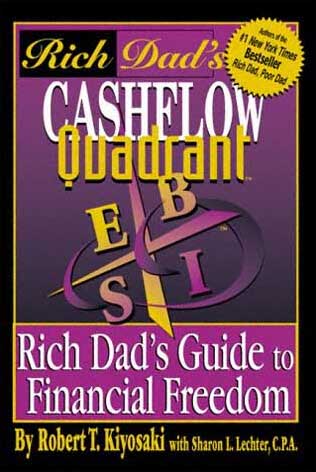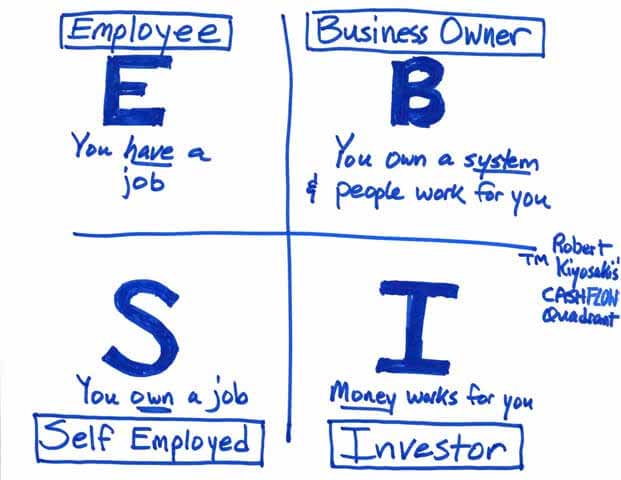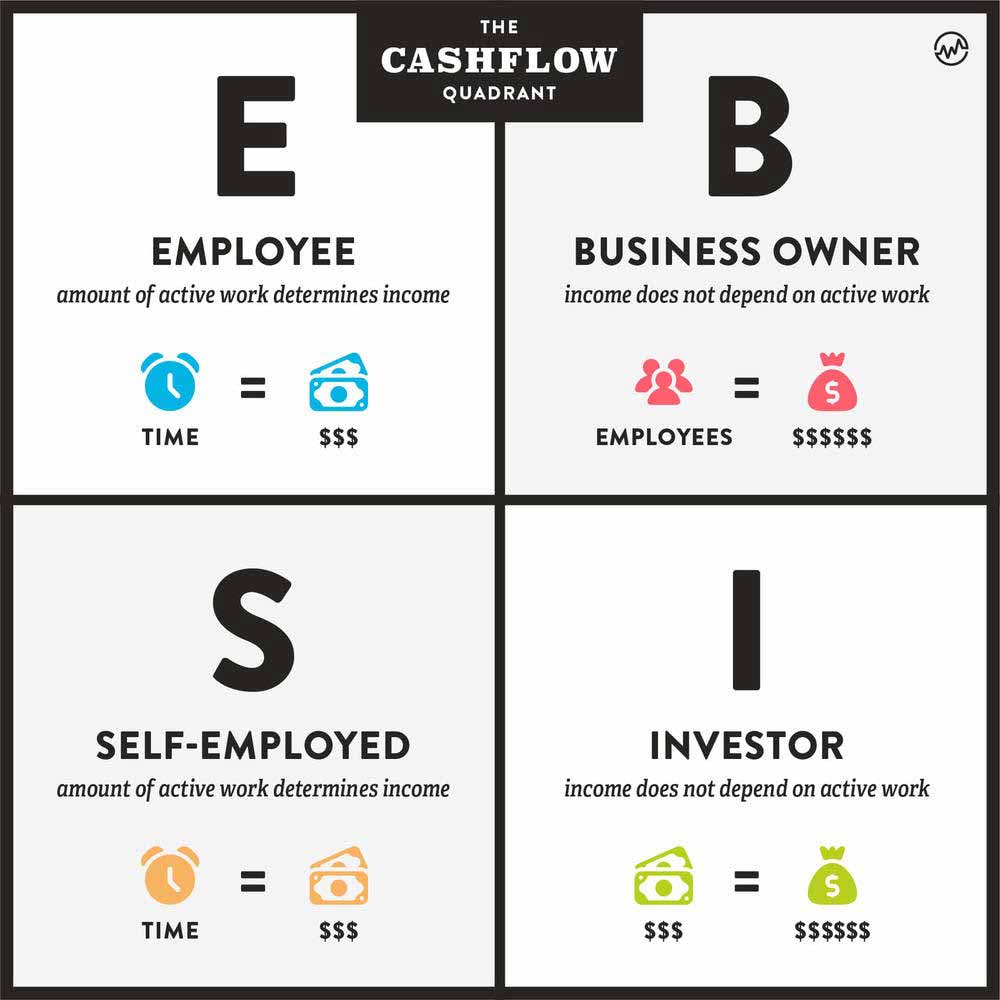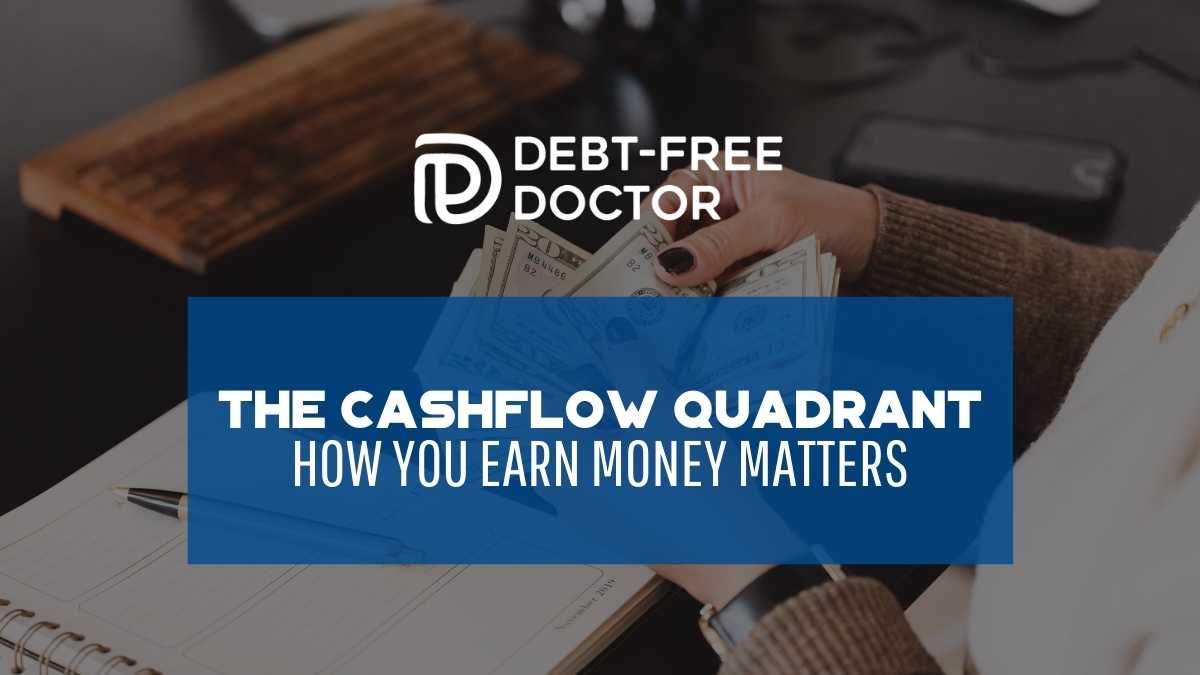Robert Kiyosaki Cashflow Quadrant
One of the ways that I develop a list of books to read (both fiction and non-fiction) is by asking successful people.
Reading fiction books not only keep me entertained, but also help with developing more creativity while writing. I now pay attention to how authors paint pictures of stories in order to increase the reader’s engagement.
Stories sell!
Reading non-fiction books is how I continue to learn and grow in areas I’m passionate about such as building wealth.
One such book, Robert Kiyosaki’s Rich Dad, Poor Dad, changed my way of thinking about personal finance and getting rich.

His follow up book, Rich Dad’s The Cashflow Quadrant, contains even more usable ideas that than his original book.
I’ve always been a visual learner and his core symbol, the cash flow quadrant, was easy to interpret to use as a path for financial freedom.
Kiyosaki’s book will help you to:
- build passive income
- retire earlier than you thought possible
- make lots of money
The only way to really become wealthy is by having your money work for you rather than you work for my money. Reread that last line until it really sinks in.
Cashflow Quadrants
If you’ve heard of Robert Kiyosaki, then you’re probably aware that his name is synonymous with real estate investing.
His four quadrants easily explains the various career paths along with our current tax system structure.
No matter what you’re opinion is of him, I have to admit, the Robert Kiyosaki Cashflow Quadrant makes sense.
It perfectly explains how our tax system has been setup and how various professionals view the world.

In the Robert Kiyosaki Cashflow Quadrant, he teaches the four ways people make money:
- Employee
- Sole Proprietor/self-employed
- Business Owner
- Investor
My Takeaway
It’s a hard pill to swallow to something that we should be doing and the book did just that for me. The truth hurts!
The Cashflow Quadrant made me realize that I needed to move from the left side of the quadrant to the right as the left side was set up for the middle class.
Not only did I need to move, but I needed to do so as fast as possible.
The book spoke loud and clear: If I (or anyone else) wants to become wealthy, you had to be on the right – Business Owner and Investor.
What Is The Robert Kiyosaki Cashflow Quadrant?
Here’s another diagram that I also found to help you visualize the point that Kiyosaki was trying to get across in the book regarding the cashflow quadrant.

Let’s dig into exactly what each side of the cashflow quadrant is all about.
First, the letters represent a type of worker (I’ll explain what each entails in more detail shortly):
- E – Employee
- S – Self-Employed
- B – Business Owner
- I – Investor
Next, the Robert Kiyosaki Cashflow Quadrant is split vertically into two halves. The E and S are paired together on the left side, and B and I are on the right.
This will become important later on when we take a look at the four categories.
Which Side Of The Cashflow Quadrant Are You On?
Active Income
Kiyosaki claims that most people are on the left side or the “poor side” of the quadrant. They’re either employees or are self-employed.
Most physicians and dentists are in these categories as you can see from the pictures above that they mainly trade their time for money.
In order for them to make money, they must perform…or they don’t get paid.
Each day they start from zero which reminds me of Bill Murray’s movie, Groundhog Day.
Everyday he started from zero and repeated the same thing over and over again never getting anywhere new in life.
“Watch out for that first step, it’s a doozy!” – Ned Ryerson
Being in the S category is what pushed me to start focusing on moving over to the right side to build passive income.
If not, I’ll always trade time for money.
Don’t Miss Any Updates. Each week I’ll send you advice on how to reach financial independence with passive income from real estate.
Sign up for my newsletterPassive Income
Kiyosaki states that we need to focus on moving over to the right or the “rich side” of the quadrant.
This is where we start generating passive income. Unfortunately, most doctors and other high-income professionals NEVER shift to this side which can lead to burn out.
With passive income, you’re able to leverage people and money to increase your wealth, even while you’re busy doing other things.
You’re literally making money while you sleep.
Cashflow Quadrant Breakdown
E – Employee
More doctors are falling into this category due to two things.
- They’re graduating with more student loan debt
- Starting a practice these days is very expensive
If people in this quadrant want more money and don’t want to move to the right side of the quadrant, they must work MORE hours. Again, continuing to trade even more time for money.
Sometimes people want to stay in this category as it typically has a higher long-term job security.
Something else to consider, employees, along with self employed individuals, pay the MOST in taxes.
S – Self Employed
I chose to be self-employed out of training because I wanted to be my own boss.
This category is one step better than an employee but those of us that reside here know that we’re still trading time for money.
If though, you theoretically own your own business, in reality the business owns you.
Similar to the employee, the self employed is one of the highest categories taxed.
B – Business Owner
Another reason why I wanted to start passively investing in real estate was to be able to take off for an extended period of time.
We love visiting the Rocky Mountains so the thought of spending the Summer out West has been weighing on me for some time now.
Those that are in the business owner category are able to take off when they choose as they have systems in place and employees that help run the business. They know out to outsource and delegate responsibilities to others.
We’re in the process of remodeling a home. I recently met with the electrician and made a comment about him probably wanting to start work before it gets too hot in the attic.
He stated, “The temperature doesn’t bother me. I’m not going to be up there running wire. My workers are.” He gets it.
Business owners are NOT trading time for money, their business generates income whether they’re present or not. What a great feeling to have.
Similar to investors, business owners pay much less in taxes than the employed/self-employed and have much more freedom.
Here’s what Kiyosaki says about this category:
Join the Passive Investors Circle“Business owners can take vacations and still make money, and they don’t have to actively work to earn an income.”
I – Investor
According to Kiyosaki, the B and I quadrants (right side) are where true financial freedom is found.
Both groups pay the least amount of taxes and don’t have to continue working for their money.
Investors own assets that make money for them.
Think Bill Gates and Warren Buffett.
The investor is the person who has earned money in one or more of the other quadrants and has put that money to work for them.
Investors often purchase assets like company shares and real estate that generate cash flow. These types of investments allow you to retire much earlier than what you’ve been led to believe.
Video
If you’re interested in hearing about the Robert Kiyosaki Cashflow Quadrant from the author himself, check out the video below:
Where Do You Want To Be?
Hopefully by now you’ve started to think a little bit more about where you are (category) and where you want to go.
This book forces us to answer a vital question:
Are you happy with how you’re making money?
Whether you realize it or not, the quadrant you reside in will inform your financial freedom as how you earn your income matters.
No matter what stage you are in your career, consider taking some time to think about where you want your professional life to take you.
Join the Passive Investors Circle

